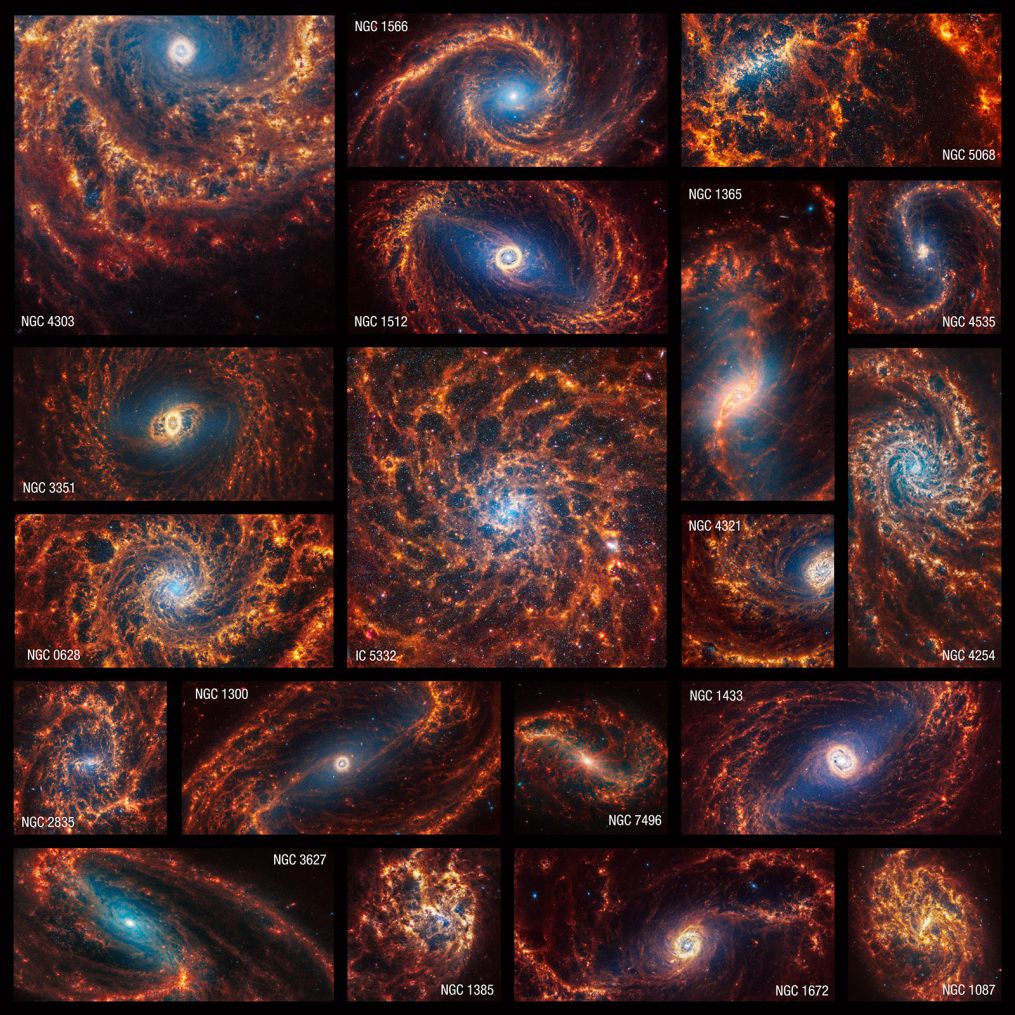(CNN) — The James Webb Space Telescope captured glowing images of 19 spiral galaxies and the millions of stars that host them, at a scale unprecedented for astronomers.
Webb's unique ability to observe the universe at different wavelengths of infrared light, such as near-infrared and mid-infrared, reveals the stars, gas and dust within the complex structure of each galaxy.
Astronomers believe that about 60% All galaxies are spiral, and our solar system is located in one of the spiral arms of the Milky Way. Webb's observations will help astronomers better understand star formation and the evolution of spiral galaxies like ours.
Viewed from the front, each galaxy in the new images has spiral arms loaded with stars. At the center of every galaxy are old star clusters or supermassive black holes.

The James Webb Space Telescope imaged 19 spiral galaxies in near- and mid-infrared light. Credit: NASA, ESA, CSA, STScI, Janice Lee (STScI), Thomas Williams (Oxford), PHANGS
Observations were made within the framework of PHANGS project (Physics at High Angular Resolution in the Nearby Galaxy). More than 100 astronomers from around the world are participating in the project, which also analyzes data from the Hubble Space Telescope, the MUSE instrument on the European Space Agency's Largest Telescope, and the Atacama Large Millimeter/Submillimeter Array in Chile.
Data from different telescopes allows astronomers to observe at different wavelengths of visible, ultraviolet and radio light. Adding Webb's infrared data can help fill in some observational gaps.
“The new web images are extraordinary,” Janice Lee, a PHANGS member and project scientist for New Missions and Strategic Initiatives at the Space Telescope Science Institute in Baltimore, said in a statement. “They are surprising even to researchers who have studied these same galaxies for decades. The bubbles and filaments are resolved at the smallest scales ever seen, and they tell a story about the cycle of star formation.”
Looking into the scrolls
Astronomers used Webb's Near Infrared Camera to observe millions of stars. For its part, the Webb Mid-Infrared Instrument focuses on the bright dust surrounding stars, as well as red stars that are shrouded in gas and dust favorable for stellar growth.
“This is where we find the newest and most massive stars in galaxies,” Eric Rosolowski, a PHANGS member and professor of physics at the University of Alberta in Edmonton, said in a statement.

This image shows observations of the galaxy NGC 4254 made by the Webb (top left) and Hubble (bottom right) telescopes. Credit: NASA, ESA, CSA, STScI, Janice Lee (STScI), Thomas Williams (Oxford), PHANGS
The spiral arms almost glow with orange and red gas in Webb's images. The images will be used to help astronomers determine the distribution of gas and dust in spiral galaxies and how galaxies feed and stop star formation.
“These structures tend to follow the same pattern in certain regions of galaxies,” Rosolowski explains. “We think of them as waves, and their spacing tells us a lot about how a galaxy distributes its gas and dust.”
The Webb telescope captured large spherical, shell-shaped gaps in the interstellar gas and dust that may have been carved by exploding stars.
“These holes may have been exploded by one or more stars, carving giant holes in the interstellar material,” Adam Leroy, a PHANGS member and professor of astronomy at The Ohio State University in Columbus, said in a statement.
Anatomy of a galaxy
Astronomers believe that galaxies form from within. Star formation begins from the center of the galaxy before spreading out into the spiral arms. This means that a star's distance from the galactic heart is related to its age, so younger stars may be farther from the galactic center. Clusters of blue stars near the centers of each galaxy represent older stars.
Meanwhile, some galaxies have pinkish-red spikes near their centers.
“This is a clear indication that there may be an active supermassive black hole,” said Eva Schinnerer, a scientist at the Max Planck Institute for Astronomy in Heidelberg, Germany. “Or, the star clusters toward the center are so bright that they fill out part of the image.”
According to Leroy, what scientists are most excited about is studying the many stars revealed by Webb's new images.
“Stars can live billions or trillions of years,” Leroy said. “By accurately cataloging all types of stars, we can create a reliable and complete view of their life cycles.”



:quality(85)/cloudfront-us-east-1.images.arcpublishing.com/infobae/GUDOKSW4URDMRAQCLHZP54673I.jpeg)

